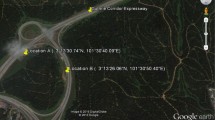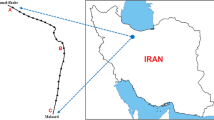Abstract
This paper deals with the control of ground surface settlement due to excavation of shallow tunnels. In order to control the settlement, one should be able to predict it, based on the prediction one may consider required preventions and protections. Prediction of surface settlement depends on several parameters and each parameter has an effect on the other. Application of the traditional methods could become impractical as the proposed equations might have low accuracy. To overcome these limitations, intelligent methods could be implemented. The present study aims to develop an intelligent model for prediction of the surface settlement in Shanghai subway line 2 project using adaptive neuro-fuzzy inference system (ANFIS). The results indicated that the proposed model had an appropriate performance. In order to perform sensitivity analysis of the ANFIS model, cosine amplitude method (CAM) was used and according to the results it was found that the operational, geometric and strength parameters had the highest impacts, respectively. Furthermore, amongst the input parameters, the two parameters of grout filling percentage (n) and grouting pressure (P) were identified as the most effective ones. The values of critical settlement were determined based on Rankin’s criteria of damage risk assessment to control the ground settlement. Then, the corresponding surface settlement was minimized by changing values of the input parameters. According to the results, control of machine operational factors particularly the n and P parameters had a crucial role in reducing surface settlement and preventing pertinent damages.







Similar content being viewed by others
References
Attewell PB, Yeates J, Selby AR (1986) Soil movements induced by tunnelling and their effects on pipelines and structures. Blackies and Sons Ltd, London
Suwansawat S (2006) Using artificial neural networks for predicting surface settlements over twin tunnels. In: International symposium on underground excavation and tunnelling, Bangkok, Thailand, 309–318
Chakeri H, Ozcelik Y, Unver B (2013) Effects of important factors on surface settlement prediction for metro tunnel excavated by EPB. Tunn Undergr Space Technol 36:14–23
Garner CD, Coffman RA (2013) Subway tunnel design using a ground surface settlement profile to characterize an acceptable configuration. Tunn Undergr Space Technol 35:219–226
Shi J, Ortigao J, Bai J (1998) Modular neural networks for predicting settlements during tunneling. J Geotech Geoenviron Eng 124(5):389–395
Kim CY, Bae G, Hong S, Park C, Moon H, Shin H (2001) Neural network based prediction of ground surface settlements due to tunnelling. Comput Geotech 28(6):517–547
Suwansawat S, Einstein HH (2006) Artificial neural networks for predicting the maximum surface settlement caused by EPB shield tunneling. Tunn Undergr Space Technol 21(2):133–150
Neaupane KM, Adhikari N (2006) Prediction of tunneling-induced ground movement with the multi-layer perceptron. Tunn Undergr Space Technol 21(2):151–159
Hou J, Zhang M, Tu M (2009) Prediction of surface settlements induced by shield tunnelling: an ANFIS model. Taylor & Francis Group, London, pp 551–554
Boubou R, Emeriault F, Kastner R (2010) Artificial neural network application for the prediction of ground surface movements induced by shield tunnelling. Can Geotech J 47(11):1214–1233
Darabi A, Ahangari K, Noorzad A, Arab A (2012) Subsidence estimation utilizing various approaches—A case study: Tehran No. 3 subway line. Tunn Undergr Space Technol 31:117–127
Ocak I, Seker SE (2013) Calculation of surface settlements caused by EPBM tunneling using artificial neural network, SVM, and Gaussian processes. Environ Earth Sci 70(3):1263–1276
Ahangari K, Moeinossadat SR, Behnia D (2015) Estimation of tunnelling-induced settlement by modern intelligent methods. Soils Found 55:737–748
Moeinossadat SR, Ahangari K, Shahriar K (2016) Calculation of maximum surface settlement induced by EPB shield tunnelling and introducing most effective parameter. J Central South Univ 23:3273–3283
Jong YH, Lee CI (2004) Influence of geological conditions on the powder factor for tunnel blasting. Int J Rock Mech Min Sci 41(3):2–12
Burland JB, Broms JB, de Mello VFB (1977) Behavior of foundations and structures on soft ground. In: Proceedings of the 9th international conference on soil Mechanics and Foundation Engineering (SMFE), Tokyo, Japan, July 10–15, 495–546
Klepikov S N (1989) Performance criteria—allowable deformations of buildings and damages. In: 12th International conference on soil mechanics and foundation engineering, Rio, General report/Discussion Session 28:2735–2744
Boscardin MD, Cording EJ (1989) Building response to excavation-induced settlement. ASCE J Geotech Eng 115(1):1–21
US. Army Corps of Engineers (1990) Engineering and design Settlement Analysis, Limitations of Settlement. Engineer Manual 1110-1-1904. Washington DC, 20314–1000
Rankin W (1988) Ground movements resulting from urban tunnelling: predictions and effects. Geol Soc Lond Eng Geol Spec Publ 5(1):79–92
Qiao J, Liu J, Guo W, Zhang Y (2010) Artificial neural network to predict the surface maximum settlement by shield tunneling. In: ICIRA’10 Proceedings of the third international conference on intelligent robotics and applications, 257–265
Whittaker B, Reddish D (1989) Subsidence: occurrence, prediction and control (developments in geotechnical engineering), vol 56. Elsevier, Amsterdam, p 528
Chakeri H, Unver B (2014) A new equation for estimating the maximum surface settlement above tunnels excavated in soft ground. Environ Earth Sci 71:3195–3210
Jang JSR (1993) ANFIS: adaptive-network-based fuzzy inference systems. IEEE Trans Syst Man Cybern 23(3):665–685
Kartalopoulos SV (1996) Understanding neural networks and fuzzy logic. Basic concepts and applications. IEEE Press, Hoboken
Jang JSR, Sun CT (1997) Neuro-fuzzy modeling and control. Proc IEEE 83(3):378–406
Jang JSR, Sun CT, Mizutani E (1997) Neuro-fuzzy and soft computing a computational approach to learning and machine intelligence. Prentice Hall, Upper Saddle River, p 640
Behnia D, Ahangari K, Noorzad A, Moeinossadat SR (2013) Predicting crest settlement in concrete face rockfill dams using adaptive neuro-fuzzy inference system and gene expression programming intelligent methods. J Zhejiang Univ Sci A: Appl Phys Eng 14(8):589–602
Ross TJ (2010) Fuzzy logic with engineering applications, 3rd edn. John Wiley & Sons, Ltd, p 585
Author information
Authors and Affiliations
Corresponding author
Rights and permissions
About this article
Cite this article
Moeinossadat, S.R., Ahangari, K. & Shahriar, K. Control of Ground Settlements Caused by EPBS Tunneling Using an Intelligent Predictive Model. Indian Geotech J 48, 420–429 (2018). https://doi.org/10.1007/s40098-017-0253-7
Received:
Accepted:
Published:
Issue Date:
DOI: https://doi.org/10.1007/s40098-017-0253-7




